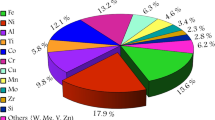The influence of chemical composition on the formation of powder particles during the water atomization of stainless steel was investigated. The formation mechanism is proposed, according to which the form of powder particles is determined by the degree of refractoriness of the oxide film formed on the droplet surface during spraying. The effect of oxide film composition on the shape of particles and the apparent density of the resulting powder is investigated. The quantitative dependences of the apparent density on the concentrations of elements additionally injected into the melt, which can form oxide films, such as Si, Al, Ti, and B, are determined. An increase in silicon or aluminum concentration leads to a decrease in particle sphericity and apparent density. Moreover, joint doping with silicon and boron leads to particle spheroidization and an increase in the apparent density of the powder. Thus, by introducing various additives to the stainless steel melt, the shape of the resulting powder particles can be adjusted so that they can be used in various technological conversions.










Similar content being viewed by others
References
O. Neikov, S. Naboychenko, and N. Yefimov, Handbook on Non-Ferrous Metal Powders: Technologies and Applications, Elsevier (2019).
Metal Powders. Products from Metal Powders [in Russian], Reference Book, eds. Prof. M.I. Alymov, PhD in Engineering, and Prof. Yu. V. Levinsky, PhD in Engineering, Vologda: Infra-Engineering, Moscow (2021).
J. J. Dunkley, “Metal powder atomization methods for modern manufacturing,” Johnson Matthey Technol. Rev., 63, No. 3, 226–232 (2019).
World Class Metal Powders, Ametek Catalog [Electronic resource] URL: http://www.powderclad.com (accessed 09.2021).
Fine Powder, Epson Atmix Corporation Catalog [Electronic resource] URL: http// www.pacificsowa.co.jp (accessed 09.2021).
O. A. Skachkov, S. Yu. Manegin, I. A. Gulyaev, A. V. Mezhevov, and P. O. Zhukov, “Investigation of the influence of high-pressure water spraying process parameters on the morphology of stainless steel powders,” Metallurg, No. 8, 43–48 (2020).
O. S. Nichiporenko, Yu. I. Naida, and A. B. Medvedovsky, Atomized Metal Powders [in Russian], Naukova Dumka, Kyiv (1980).
Sugiura Saburo, Kusaka Kastushi, Demukai Noboru, and Notoh Akira, “Studies on manufacturing of spherical alloy powders by atomization of melt,” DENKI-SEIKO, 51, 242–251 (1980).
J. J. Dunkley, “The production of metal powders by water atomization,” Powder Metal. Int., No. 10, 38–41 (1978).
J. J. Dunkley, “Advances in Atomisation Techniques for the Formation of Metal Powders, Advances in Powder Metallurgy: Properties,” in: Processing and Applications, Woodhead Publishing Series in Metals and Surface Engineering (2013), pp. 3–18.
GOST 19440-94. Metal Powders. Determination of Apparent Density.
B. A. Baum, Metallic Liquids – Problems and Hypotheses [in Russian], Nauka, Moscow (1979).
N. A. Toropov, V. P. Barzakovsky, V. V. Lapin, and N. N. Kurtseva, State Diagrams of Silicate Systems [in Russian], Nauka, Leningrad. br., Leningrad (1969).
Author information
Authors and Affiliations
Corresponding author
Additional information
Translated from Metallurg, Vol. 67, No. 1, pp. 57–63, January, 2023. Russian DOI https://doi.org/10.52351/00260827_2023_01_57.
Rights and permissions
Springer Nature or its licensor (e.g. a society or other partner) holds exclusive rights to this article under a publishing agreement with the author(s) or other rightsholder(s); author self-archiving of the accepted manuscript version of this article is solely governed by the terms of such publishing agreement and applicable law.
About this article
Cite this article
Manegin, S.Y., Rozanov, S.D., Gulyaev, I.A. et al. Influence of Melt Composition on the Formation of Powder Particles When Spraying High-Alloy Steels with High-Pressure Water. Metallurgist 67, 51–58 (2023). https://doi.org/10.1007/s11015-023-01488-2
Received:
Revised:
Accepted:
Published:
Issue Date:
DOI: https://doi.org/10.1007/s11015-023-01488-2




